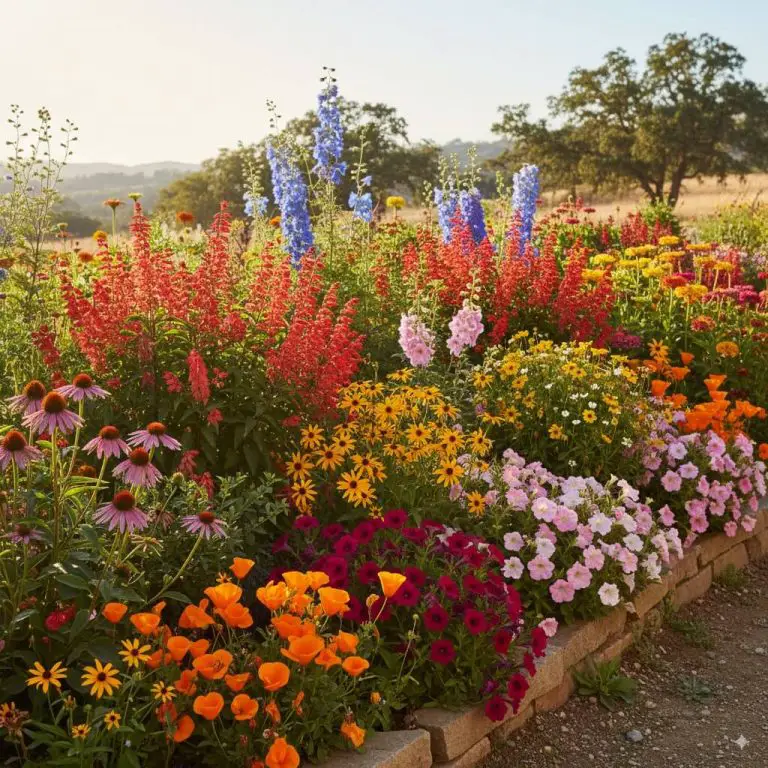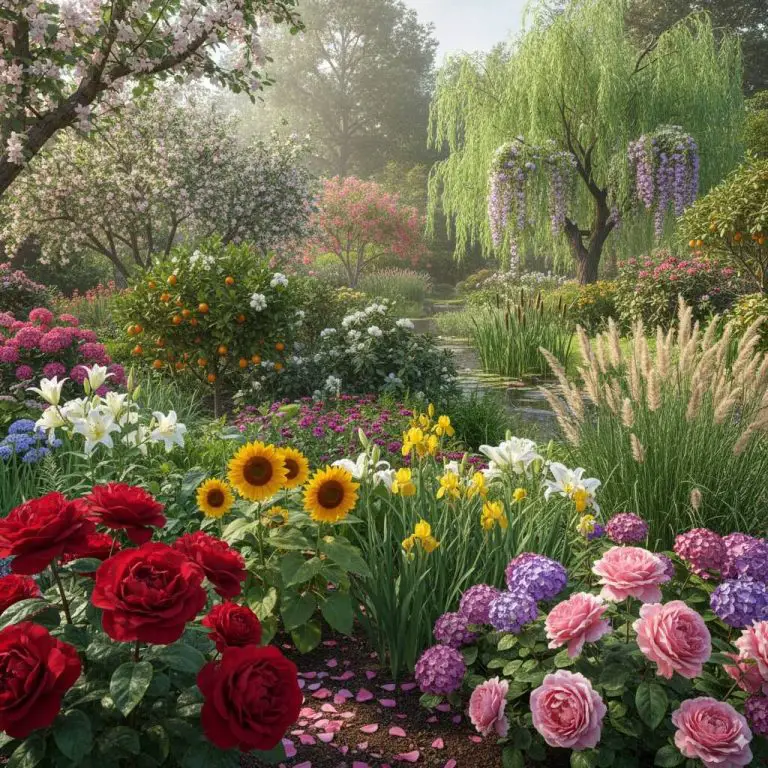Late Summer Flowering Plants – Your Complete Guide To A Dazzling
Does your garden start to look a little tired as August rolls around? Do the vibrant colors of June and July begin to fade, leaving you wishing the show could last just a bit longer? It’s a common feeling among gardeners, but I’m here to let you in on a little secret: your garden’s grand finale is yet to come.
Don’t pack up your gardening gloves just yet! I promise that by choosing the right plants, you can orchestrate a second peak season of breathtaking color that carries you right into autumn. These blooms aren’t just an afterthought; they are the resilient, show-stopping stars that shine when others have faded.
In this complete late summer flowering plants guide, we’ll explore my absolute favorite powerhouse perennials that save their best for last. We will cover everything from essential care tips to keep them thriving, to solving common problems, and even how these beautiful additions create a more sustainable, eco-friendly garden. Let’s get started!
What's On the Page
- 1 Why Your Garden Desperately Needs Late Summer Flowering Plants
- 2 Our Top 5 Tried-and-True Late Summer Flowering Plants
- 3 The Ultimate Late Summer Flowering Plants Care Guide
- 4 Common Problems with Late Summer Flowering Plants (And How to Fix Them!)
- 5 Best Practices for a Dazzling Late-Season Design
- 6 Frequently Asked Questions About Late Summer Flowering Plants
- 7 Your Best Garden Season is Still Ahead
Why Your Garden Desperately Needs Late Summer Flowering Plants
You might think of late summer as the wind-down period, but it’s actually a crucial time in the garden’s lifecycle. Introducing plants that thrive now offers a cascade of rewards that go far beyond just a pretty view.
One of the most significant benefits of late summer flowering plants is the extended season of interest. Just when your early-season bloomers are finishing, these latecomers step into the spotlight, ensuring your garden remains a vibrant, living space well into the cooler months. They bridge the gap between the peak of summer and the first frost with a flourish of golds, purples, and rich jewel tones.

🌿 The Companion Planting & Gardening Book (eBook)
Bigger harvests, fewer pests — natural pairings & simple layouts. $6.99
Get – $6.99
🪴 The Pest-Free Indoor Garden (eBook)
DIY sprays & soil tips for bug-free houseplants. $4.89
Get – $4.99Beyond aesthetics, these plants are an ecological lifeline. They provide a critical late-season source of nectar and pollen for pollinators like bees, butterflies, and hoverflies. As other food sources dwindle, your garden becomes a vital sanctuary, supporting local wildlife as they prepare for winter. This is a simple yet powerful way to practice eco-friendly late summer flowering plants gardening.
Our Top 5 Tried-and-True Late Summer Flowering Plants
Over the years, I’ve experimented with dozens of late-season bloomers, and a few have earned a permanent place in my heart and my garden beds. These five are reliable, beautiful, and relatively easy to care for. Don’t worry—these flowers are perfect for beginners!
1. Stonecrop (Hylotelephium ‘Autumn Joy’)
If I could only choose one late-season perennial, it would be this one. ‘Autumn Joy’ Sedum is the definition of a four-season plant. Its broccoli-like green heads appear in summer, slowly blushing to a soft pink in late summer before deepening to a spectacular rusty red in the fall.
- Sun Needs: Full sun is best.
- Soil: Thrives in average, well-drained soil. It’s incredibly drought-tolerant once established.
- Pro Tip: Resist the urge to cut the dried seed heads back in winter. They provide wonderful structure and look stunning dusted with frost, while also providing shelter for beneficial insects.
2. New England Aster (Symphyotrichum novae-angliae)
Nothing says “autumn” quite like a cloud of purple Asters. These native powerhouses are covered in daisy-like flowers with bright yellow centers. They are an absolute magnet for monarch butterflies fueling up for their migration.
- Sun Needs: Full sun.
- Soil: Prefers moist, rich soil but is quite adaptable.
- Pro Tip: To prevent them from getting too tall and floppy, give them the “Chelsea Chop” in late spring. Simply cut the entire plant back by about one-third. You’ll be rewarded with a sturdier, bushier plant with even more flowers.
3. Black-Eyed Susan (Rudbeckia fulgida)
The cheerful, golden-yellow faces of Rudbeckia can brighten even the cloudiest late summer day. This plant is a workhorse, blooming for weeks on end with minimal fuss. It’s a classic for a reason—it’s dependable, beautiful, and pollinators adore it.
- Sun Needs: Full sun to light shade.
- Soil: Adapts to a wide range of soils, as long as they are not consistently wet.
- Pro Tip: Deadhead spent blooms to encourage a longer flowering period. However, leave some seed heads on at the end of the season, as goldfinches love to feast on the seeds. This is a key part of creating sustainable late summer flowering plants habitats.
4. Japanese Anemone (Eriocapitella hupehensis)
For a touch of elegance in the late-season garden, look no further than Japanese Anemones. Their delicate, cup-shaped flowers in shades of white and pink dance on tall, wiry stems, catching the breeze beautifully. They bring a sense of grace and movement when many other plants are looking static.
- Sun Needs: Part shade, especially protection from hot afternoon sun.
- Soil: Rich, moist, well-drained soil.
- Pro Tip: Anemones can be slow to establish, so be patient. They spread by underground runners to form a lovely colony over time. Choose their location carefully, as they don’t like to be moved once settled.
5. Joe Pye Weed (Eutrochium purpureum)
If you want to make a bold statement, Joe Pye Weed is your plant. Reaching heights of 5-7 feet, its enormous, dusty-rose flower heads are a sight to behold. It’s a cornerstone species for any pollinator garden, attracting a dizzying array of butterflies.
- Sun Needs: Full sun to part shade.
- Soil: Loves consistently moist soil. It’s perfect for the back of a border or a damp spot in the yard.
- Pro Tip: Due to its height, it can sometimes flop. Plant it near a fence or provide some staking for support, or choose a shorter cultivar like ‘Little Joe’.
The Ultimate Late Summer Flowering Plants Care Guide
Knowing how to late summer flowering plants thrive is key to a glorious autumn display. The conditions are different from spring—the sun is intense, the soil is warm, and water can be scarce. Here are some essential tips.
Watering Wisely in the Heat
Late summer can bring long, dry spells. It’s better to water your plants deeply and infrequently rather than giving them a light sprinkle every day. This encourages roots to grow deeper into the soil where it’s cooler and more moisture is available. Applying a 2-3 inch layer of organic mulch (like shredded bark or compost) is a game-changer. It helps retain soil moisture, suppresses weeds, and keeps roots cool.
Feeding for Fall Flowers
Be careful with fertilizer at this time of year. A final, light feeding with a balanced, low-nitrogen fertilizer in mid-summer can help fuel bloom production. Avoid high-nitrogen fertilizers, which encourage leafy green growth at the expense of flowers. For most established perennials, a top-dressing of compost in the spring is all they really need.
Deadheading and Pruning for More Blooms
Deadheading, or removing spent flowers, is one of the best ways to keep the show going. For plants like Rudbeckia and Coneflower, snipping off old blooms tells the plant to produce more flowers instead of setting seed. This simple task can extend the blooming period by several weeks.
Common Problems with Late Summer Flowering Plants (And How to Fix Them!)
Even the toughest plants can face challenges. Here are a few common issues you might encounter and my simple, eco-friendly solutions.
Pesky Powdery Mildew
You might notice a white, dusty coating on the leaves of plants like Phlox or Bee Balm, especially during humid weather. This is powdery mildew, a fungal disease. The best defense is prevention: give plants plenty of space for good air circulation and water the soil, not the leaves. If it appears, you can often manage it with a spray of neem oil or a simple homemade solution of one tablespoon of baking soda in a gallon of water.
Leggy Growth and Flopping
Sometimes, tall plants like Asters and Joe Pye Weed can get “leggy” and flop over, especially after a heavy rain. This can be caused by too much shade or overly rich soil. As mentioned earlier, the “Chelsea Chop” in late spring is a fantastic preventative measure for next year. For this season, you can use bamboo stakes and twine or a grow-through plant support to gently hold them upright.
Best Practices for a Dazzling Late-Season Design
A little planning goes a long way. Following a few late summer flowering plants best practices for design can elevate your garden from a simple collection of plants to a cohesive, stunning landscape.
Plant in Drifts and Layers
Avoid planting single specimens. For the most natural and impactful look, plant in groups or “drifts” of three, five, or seven. This creates a satisfying sweep of color. Also, think in layers: place taller plants like Joe Pye Weed at the back of the border, mid-height plants like Asters in the middle, and shorter ones like Sedum at the front.
Combine Textures and Forms
Great garden design is about more than just color. Think about texture! Pair the bold, rounded flower heads of Sedum with the delicate, airy wands of Russian Sage or the fine texture of an ornamental grass. The contrast in form and texture creates a garden that is visually interesting even when things aren’t in bloom.
Frequently Asked Questions About Late Summer Flowering Plants
When is the best time to plant late summer bloomers?
The ideal time to plant most perennials, including late summer bloomers, is in the spring. This gives them a full season to establish a strong root system before they need to put on their big floral show. Planting in early fall is also a great option in many climates.
Can I grow these plants in containers?
Absolutely! Many late summer flowering plants do wonderfully in containers. Shorter varieties of Aster, Sedum, and Coneflower are excellent choices. Just be sure to use a large pot with good drainage and a high-quality potting mix. Container plants will also need more frequent watering than those in the ground.
Do I need to cut these plants back in the fall?
My advice is to wait until spring! Leaving the seed heads and stems standing provides crucial winter habitat and food for birds and beneficial insects. Plus, the architectural forms of plants like Sedum and ornamental grasses look absolutely magical covered in frost or snow. This is a core principle of sustainable late summer flowering plants gardening.
Your Best Garden Season is Still Ahead
See? The end of summer doesn’t have to mean the end of your garden’s beauty. By embracing the power and resilience of late summer flowering plants, you can create a landscape that is vibrant, full of life, and ecologically important deep into the autumn months.
Remember to choose the right plants for your space, water them deeply, and don’t be afraid to let them stand through the winter. Your garden—and your local pollinators—will thank you for it.
Now go forth and plant for a spectacular fall finale. Happy gardening!
- Are You Supposed To Trim Cucumber Plants – The Complete Guide To - November 7, 2025
- Persian Cucumber Plant Spacing – The Secret To Preventing Disease And - November 7, 2025
- How Much Room Does A Cucumber Plant Need To Grow – Spacing For A Huge - November 7, 2025


